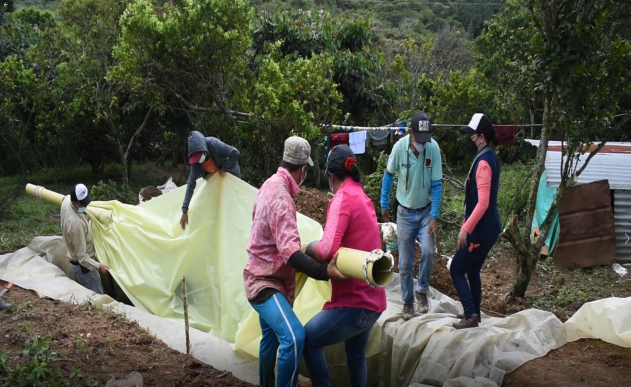In the scope of its 2022 annual campaign on the theme of sustainable construction in Latin America, the setec Foundation is supporting a project to restore a hydraulic system for a rural community in Colombia. This project is made possible by the involvement of employees of the local subsidiary of the setec Group, Gomez Cajaio, who have sponsored this project and will participate in its implementation by sharing their skills.
The context
Located in the Yariguies mountain range, in the center of the Colombian department of Santander, the municipality of Guadalupe counts some 5,000 inhabitants.
Near Guadalupe is the community of Quitasol, whose access to water depends on a community aqueduct built on the initiative of community leaders almost 50 years ago. This aqueduct provides drinking water from the Magdalena River, and hundreds of people rely on it for access to clean water and essential sanitation services.

Management of the hydraulic system by the community ©El Comun
The current aqueduct, which has been in use for more than 50 years and is self-managed by the community, is no longer able to meet these needs; firstly, because the various elements that make it up are no longer in optimal working order (pipes, tanks, etc.), but also because the coverage of this hydraulic system is no longer sufficient for the number of households established in Quitasol, which has been increasing since the aqueduct was built.
The El Comun association proposed a project to the setec Foundation to restore this community hydraulic system.
The project
The project consists of the restoration of the entire hydraulic system, including the replacement of damaged elements such as pipes, and responds to the need for water resources for the local communities to improve living conditions and hygiene. The use of the aqueduct is in fact reserved for domestic use. It thus directly benefits the population.

setec Gomez Cajiao employees and members of the community ©El Comun
It will take place in three stages:
- Firstly, during fieldwork carried out voluntarily by Gomez Cajiao engineers who will carry out a topographical survey and a characterization of the water.
- Secondly, a diagnosis and detailed designs will be carried out, such as the compilation of the analysis of the data obtained during the fieldwork, as well as the carrying out of a hydrological study accompanied by hydraulic designs for the renovation of the aqueduct.
- Finally, a construction phase, which will be carried out by local community members directly, will allow for a direct increase in skills and an economic valuation of their activity in this project. Several members of the community have construction skills that will be valorized, and this approach will allow the community to continue its self-management of the aqueduct, as it has been doing for years.
The various stages of the project are spread over a period of 5 months, with most of the time spent working on the restoration of the water system.
Sustainable construction
The restoration of the aqueduct’s hydraulic infrastructure is in line with the theme of sustainable construction, as it avoids the need to build a new system to meet the water needs of the Quitasol community.
Indeed, the restoration of the existing pipes will allow the implementation of a net zero deforestation project, in a region where the balance of the forest ecosystem is essential for the local population.
In addition, the restoration of the hydraulic systems will allow a better efficiency and a reduction of water losses along the pipes.
